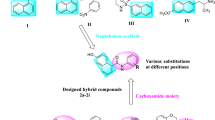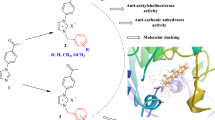Abstract
A library of piperonylic acid-derived hydrazones possessing variable aryl moiety was synthesized and investigated for their multifunctional properties against cholinesterases (ChEs) and monoamine oxidases (MAOs). The in vitro enzymatic assay results revealed that the tested hydrazones have exhibited excellent cholinesterase inhibition profile. Compound 4i, (E)-N'-(2,3-dichlorobenzylidene)benzo[d][1,3]dioxole-5-carbohydrazide showed promising dual inhibitory profile against AChE (0.048 ± 0.007 μM), BChE (0.89 ± 0.018 μM), and MAO-B (0.95 ± 0.12 μM) enzymes. SAR exploration revealed that the truncation of the linker connecting both the aryl binding sites of the semicarbazone scaffold, by one atom, has relatively suppressed the AChE inhibitory potential. Kinetic studies disclosed that the compound 4i reversibly inhibited AChE enzyme in a competitive manner (Ki = 8.0 ± 0.076 nM), while it displayed a non-competitive and reversible inhibition profile against MAO-B (Ki = 9.6 ± 0.021 µM). Moreover, molecular docking studies of synthesized compounds against ChEs and MAOs provided the crucial molecular features that enable their close association and interaction with the target enzymes. All atomistic simulation studies confirmed the stable association of compound 4i within the active sites of AChE and MAO-B. In addition, theoretical ADMET prediction studies demonstrated the acceptable pharmacokinetic profile of the dual inhibitors. In summary, the attempted lead simplification study afforded a potent dual ChE–MAO-B inhibitor compound that merits further investigation.
Graphical abstract











Similar content being viewed by others
References
Walczak-Nowicka ŁJ, Herbet M (2021) Acetylcholinesterase inhibitors in the treatment of neurodegenerative diseases and the role of acetylcholinesterase in their pathogenesis. Int J Mol Sci. https://doi.org/10.3390/ijms22179290
Singh J, Kour K, Jayaram MB (2012) Acetylcholinesterase inhibitors for schizophrenia. Cochrane Database Syst Rev 1(1):CD007967
Massoulie J et al (1993) Chapter 15: Structure and functions of acetylcholinesterase and butyrylcholinesterase. In: Cuello AC (ed) Progress in brain research. Elsevier, Amsterdam, pp 139–146
Girard E et al (2007) Butyrylcholinesterase and the control of synaptic responses in acetylcholinesterase knockout mice. Life Sci 80(24–25):2380–2385. https://doi.org/10.1016/j.lfs.2007.03.011
Dvir H et al (2010) Acetylcholinesterase: from 3D structure to function. Chem Biol Interact 187(1):10–22. https://doi.org/10.1016/j.cbi.2010.01.042
Muller T, Riederer P, Grünblatt E (2017) Determination of monoamine oxidase A and B activity in long-term treated patients with Parkinson disease. Clin Neuropharmacol. https://doi.org/10.1097/WNF.0000000000000233
Tripathi RKP, Ayyannan SR (2019) Monoamine oxidase-B inhibitors as potential neurotherapeutic agents: an overview and update. Med Res Rev 39(5):1603–1706. https://doi.org/10.1002/med.21561
Islam MT (2017) Oxidative stress and mitochondrial dysfunction-linked neurodegenerative disorders. Neurol Res 39(1):73–82. https://doi.org/10.1080/01616412.2016.1251711
Fisar Z (2016) Drugs related to monoamine oxidase activity. Prog Neuropsychopharmacol Biol Psychiatry 69:112–124. https://doi.org/10.1016/j.pnpbp.2016.02.012
Kumar S, Ayyannan SR (2022) Identification of new small molecule monoamine oxidase-B inhibitors through pharmacophore-based virtual screening, molecular docking and molecular dynamics simulation studies. J Biomol Struct Dyn. https://doi.org/10.1080/07391102.2022.2112082
Borroni E et al (2017) Sembragiline: a novel, selective monoamine oxidase type B inhibitor for the treatment of Alzheimer’s disease. J Pharmacol Exp Ther 362(3):413–423. https://doi.org/10.1124/jpet.117.241653
Cevik UA et al (2020) Multifunctional quinoxaline-hydrazone derivatives with acetylcholinesterase and monoamine oxidases inhibitory activities as potential agents against Alzheimer’s disease. Med Chem Res 29(6):1000–1011. https://doi.org/10.1007/s00044-020-02541-4
Jeong GS et al (2020) Selected 1,3-benzodioxine-containing chalcones as multipotent oxidase and acetylcholinesterase inhibitors. ChemMedChem 15(23):2257–2263. https://doi.org/10.1002/cmdc.202000491
Yamali C et al (2021) Phenothiazine-based chalcones as potential dual-target inhibitors toward cholinesterases (AChE, BuChE) and monoamine oxidases (MAO-A, MAO-B). J Heterocycl Chem 58(1):161–171. https://doi.org/10.1002/jhet.4156
Vishnu MS et al (2019) Experimental and computational evaluation of piperonylic acid derived hydrazones bearing isatin moieties as dual inhibitors of cholinesterases and monoamine oxidases. ChemMedChem 14(14):1359–1376. https://doi.org/10.1002/cmdc.201900277
Plazas E et al (2020) Isoquinoline alkaloids from the roots of Zanthoxylum rigidum as multi-target inhibitors of cholinesterase, monoamine oxidase A and Aβ1-42 aggregation. Bioorg Chem 98:103722. https://doi.org/10.1016/j.bioorg.2020.103722
Kumar V et al (2020) Design, synthesis and evaluation of O-pentyne substituted diphenylpyrimidines as monoamine oxidase and acetylcholinesterase inhibitors. ChemistrySelect 5(27):8021–8032. https://doi.org/10.1002/slct.202002425
Ramsay RR (2016) Molecular aspects of monoamine oxidase B. Prog Neuropsychopharmacol Biol Psychiatry 69:81–89. https://doi.org/10.1016/j.pnpbp.2016.02.005
Marco-Contelles J et al (2016) ASS234, as a new multi-target directed propargylamine for Alzheimer’s disease therapy. Front Neurosci 10:294. https://doi.org/10.3389/fnins.2016.00294
Bautista-Aguilera OM et al (2017) Multitarget-directed ligands combining cholinesterase and monoamine oxidase inhibition with histamine H3R antagonism for neurodegenerative diseases. Angew Chem Int Ed 56(41):12765–12769. https://doi.org/10.1002/anie.201706072
Xu Y et al (2019) Rational design of novel selective dual-target inhibitors of acetylcholinesterase and monoamine oxidase B as potential anti-Alzheimer’s disease agents. ACS Chem Neurosci 10(1):482–496. https://doi.org/10.1021/acschemneuro.8b00357
Joubert J et al (2017) Synthesis and evaluation of 7-substituted coumarin derivatives as multimodal monoamine oxidase-B and cholinesterase inhibitors for the treatment of Alzheimer’s disease. Eur J Med Chem 125:853–864. https://doi.org/10.1016/j.ejmech.2016.09.041
Pan L-F, Wang X-B, Xie S-S, Li SY, Kong LY (2014) Multitarget-directed resveratrol derivatives: anti-cholinesterases, anti-β-amyloid aggregation and monoamine oxidase inhibition properties against Alzheimer’s disease. MedChemComm 5(5):609–616. https://doi.org/10.1039/C3MD00376K
Verma G et al (2014) A review exploring biological activities of hydrazones. J Pharm Bioallied Sci 6(2):69–80
de Oliveira Carneiro Brum J et al (2020) Synthesis and biological activity of hydrazones and derivatives: a review. Mini Rev Med Chem 20(5):342–368. https://doi.org/10.2174/1389557519666191014142448
Rollas S, Kucukguzel SG (2007) Biological activities of hydrazone derivatives. Molecules 12(8):1910–1939. https://doi.org/10.3390/12081910
Ali MR et al (2012) Review of biological activities of hydrazones. Indones J Pharm 23(4):193–202
Tripathi RKP, Rai GK, Ayyannan SR (2016) Exploration of a library of 3,4-(methylenedioxy)aniline-derived semicarbazones as dual inhibitors of monoamine oxidase and acetylcholinesterase: design, synthesis, and evaluation. ChemMedChem 11(11):1145–1160. https://doi.org/10.1002/cmdc.201600128
Goodsell DS, Morris GM, Olson AJ (1996) Automated docking of flexible ligands: applications of autodock. J Mol Recognit 9(1):1–5. https://doi.org/10.1002/(SICI)1099-1352(199601)9:1%3c1::AID-JMR241%3e3.0.CO;2-6
Lee S et al (2003) The PreADME Approach: Web-based program for rapid prediction of physico-chemical, drug absorption and drug-like properties. euro QSAR 2002 - Designing Drugs and Crop Protectants: Processes Problems and Solutions 2003. pp 418–420
Siddiqa A et al (2014) Synthesis and antibacterial evaluation of 2-(1, 3-benzodioxol-5-ylcarbonyl) arylsulfonohydrazide derivatives. Trop J Pharm Res 13(10):1689–1696. https://doi.org/10.4314/tjpr.v13i10.17
Cheung J et al (2013) Structures of human acetylcholinesterase bound to dihydrotanshinone I and territrem B show peripheral site flexibility. ACS Med Chem Lett 4(11):1091–1096. https://doi.org/10.1021/ml400304w
Kosak U et al (2016) Development of an in-vivo active reversible butyrylcholinesterase inhibitor. Sci Rep 6(1):39495. https://doi.org/10.1038/srep39495
Warren GL et al (2012) Essential considerations for using protein–ligand structures in drug discovery. Drug Discov Today 17(23):1270–1281. https://doi.org/10.1016/j.drudis.2012.06.011
Bowers KJ et al (2006) Scalable Algorithms for Molecular Dynamics Simulations on Commodity Clusters. In SC '06: Proceedings of the 2006 ACM/IEEE Conference on Supercomputing. p 43 https://doi.org/10.1109/SC.2006.54
Tripathi RKP et al (2018) Design, synthesis, and pharmacological evaluation of 2-amino-5-nitrothiazole derived semicarbazones as dual inhibitors of monoamine oxidase and cholinesterase: effect of the size of aryl binding site. J Enzyme Inhib Med Chem 33(1):37–57. https://doi.org/10.1080/14756366.2017.1389920
Tripathi RKP, Krishnamurthy S, Ayyannan SR (2016) Discovery of 3-hydroxy-3-phenacyloxindole analogues of isatin as potential monoamine oxidase inhibitors. ChemMedChem 11(1):119–132. https://doi.org/10.1002/cmdc.201500443
Son S-Y et al (2008) Structure of human monoamine oxidase A at 2.2-Å resolution: the control of opening the entry for substrates/inhibitors. Proc Natl Acad Sci 105(15):5739–5744. https://doi.org/10.1016/j.bmc.2021.116558
Binda C et al (2007) Structures of human monoamine oxidase B complexes with selective noncovalent inhibitors: safinamide and coumarin analogs. J Med Chem 50(23):5848–5852. https://doi.org/10.1021/jm070677y
Jaiswal S, Tripathi RKP, Ayyannan SR (2018) Scaffold hopping-guided design of some isatin based rigid analogs as fatty acid amide hydrolase inhibitors: synthesis and evaluation. Biomed Pharmacother 107:1611–1623. https://doi.org/10.1016/j.biopha.2018.08.125
Singh SK et al (2014) The flavonoid derivative 2-(4′-benzyloxyphenyl)-3-hydroxy-chromen-4-one protects against aβ42-induced neurodegeneration in transgenic drosophila: insights from in silico and in vivo studies. Neurotox Res 26(4):331–350. https://doi.org/10.1007/s12640-014-9466-z
Lipinski CA (2004) Lead- and drug-like compounds: the rule-of-five revolution. Drug Discov Today Technol 1(4):337–341. https://doi.org/10.1016/j.ddtec.2004.11.007
Oprea TI (2000) Property distribution of drug-related chemical databases*. J Comput Aided Mol Des 14:251–264. https://doi.org/10.1023/A:1008130001697
Kummerle AE et al (2009) Studies towards the identification of putative bioactive conformation of potent vasodilator arylidene N-acylhydrazone derivatives. Eur J Med Chem 44(10):4004–4009. https://doi.org/10.1016/j.ejmech.2009.04.044
Lima PC et al (2000) Synthesis and analgesic activity of novel N-acylarylhydrazones and isosters, derived from natural safrole. Eur J Med Chem 35(2):187–203. https://doi.org/10.1016/S0223-5234(00)00120-3
Mazzone G, Bonina F, Formica F (1978) Some aroylhydrazones of halobenzaldehydes and halogen-substituted 2,5-diaryl-1,3,4-oxadiazoles. Farmaco Sci 33(12):963–971
Mazzone G, Arrigo Reina R (1973) Synthesis of 3,4-(methylenedioxy)-benzoic acid hydrazides and their antimonoaminoxidasic activity. Boll Chim Farm 112(1):35–44
Pham VHP et al (2005) Synthesis, structures of 2,5-diaryl-1,3,4-oxadiazoles from safrole. Tap Chi Hoa Hoc 43(2):198–202
Devi J et al (2021) Design, synthesis, crystal structure, molecular docking studies of some diorganotin(IV) complexes derived from the piperonylic hydrazide Schiff base ligands as cytotoxic agents. J Mol Struct 1232:129992. https://doi.org/10.1016/j.molstruc.2021.129992
Ellman GL (1958) A colorimetric method for determining low concentrations of mercaptans. Arch Biochem Biophys 74(2):443–450. https://doi.org/10.1016/0003-9861(58)90014-6
Jaiswal S, Ayyannan SR (2022) Discovery of isatin-based carbohydrazones as potential dual inhibitors of fatty acid amide hydrolase and monoacylglycerol lipase. ChemMedChem 17(1):e202100559. https://doi.org/10.1002/cmdc.202100559
Acknowledgements
The first author (Pavan Kumar V.) is thankful to the Indian Institute of Technology (BHU) Varanasi, for providing a Teaching Assistantship. The support and the resources provided by ‘PARAM Shivay Facility’ under the National Supercomputing Mission, Government of India at the Indian Institute of Technology (BHU), Varanasi are gratefully acknowledged.
Author information
Authors and Affiliations
Corresponding author
Additional information
Publisher's Note
Springer Nature remains neutral with regard to jurisdictional claims in published maps and institutional affiliations.
Supplementary Information
Below is the link to the electronic supplementary material.
Rights and permissions
Springer Nature or its licensor (e.g. a society or other partner) holds exclusive rights to this article under a publishing agreement with the author(s) or other rightsholder(s); author self-archiving of the accepted manuscript version of this article is solely governed by the terms of such publishing agreement and applicable law.
About this article
Cite this article
Kumar, V.P., Vishnu, M.S., Kumar, S. et al. Exploration of a library of piperonylic acid-derived hydrazones possessing variable aryl functionalities as potent dual cholinesterase and monoamine oxidase inhibitors. Mol Divers 27, 2465–2489 (2023). https://doi.org/10.1007/s11030-022-10564-9
Received:
Accepted:
Published:
Issue Date:
DOI: https://doi.org/10.1007/s11030-022-10564-9




